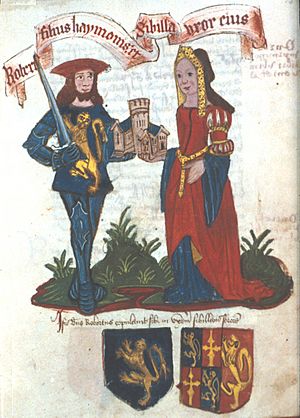Robert Fitzhamon facts for kids
Quick facts for kids
Robert FitzHamon
|
|
|---|---|

Robert FitzHamon and his wife Sibilla, shown as founders of Tewkesbury Abbey. From a 15th-century manuscript.
|
|
| Born | c. 1045-1055 |
| Died | March 1107 |
| Spouse(s) | Sybil de Montgomery (Sybil de Montgomerie) |
| Father | Hamo Dapifer |
Robert FitzHamon (died March 1107) was a powerful Norman lord. His name means "Robert, son of Hamon." He came from Normandy, a region in France. Robert was the first Norman ruler of Gloucester in England. He also conquered Glamorgan in southern Wales. He became the Lord of Glamorgan around 1075.
Robert was a relative of William the Conqueror. He was also very loyal to kings William Rufus and Henry I of England. This made him an important person in both England and Normandy.
Contents
Robert's Early Life
Robert FitzHamon was likely born between 1040 and 1050. His father was Hamo Dapifer, who was the Sheriff of Kent. His grandfather was named Hamon Dentatus. This name meant "The Betoothed" or "Toothy." Robert's grandfather owned several lands in Normandy. These included Torigny, Creully, Mézy, and Evrecy. But after his grandfather died in battle in 1047, the family might have lost these lands. Robert was related to William the Conqueror, but the exact family link is not known.
Robert's Career in England and Wales
We don't know much about Robert's early career before 1087. He probably did not fight in the famous Battle of Hastings in 1066. His name also doesn't appear in the Domesday Book of 1086. This book listed all the land and property in England.
Robert first became well-known as a supporter of King William Rufus. This was during a rebellion in 1088. After the king won, Robert was rewarded. King William Rufus gave him the large feudal barony of Gloucester. This included over 200 estates, called manors, in Gloucestershire and other areas. Some of these lands had belonged to Queen Matilda of Flanders, William the Conqueror's wife. She had taken them from a powerful Saxon lord named Brictric son of Algar. These lands were meant for Rufus's younger brother, Henry. But Robert FitzHamon still remained good friends with Henry.
Conquering Glamorgan
We are not completely sure when Robert conquered Glamorgan. It likely happened in the years after he received the Gloucester lands. A popular story, from the 1500s, tells how the Welsh Prince Iestyn ap Gwrgan asked Robert FitzHamon for help. Iestyn was the prince of Glamorgan. Robert and his Norman knights supposedly helped Iestyn defeat another Welsh prince, Rhys ap Tewdwr, in 1090.
After the victory, Robert and his knights took control of Glamorgan. The story says "the French came into Dyfed and Ceredigion." They built castles and took over the land. Prince Iestyn did not benefit for long. He was soon defeated, and his lands were taken in 1091.
Whether this legend is true or not, Robert FitzHamon did take control of the lowlands of Glamorgan. This happened between 1089 and 1094. His main strongholds were Cardiff Castle, which might have been an old Roman fort. He also built new castles at Newport and Kenfig. Robert's family would later inherit these castles and lands.
Founding Tewkesbury Abbey
In 1092, Robert FitzHamon helped rebuild Tewkesbury Abbey. This was a large and important church. The abbey was almost as big as Westminster Abbey. The first abbot (head of the abbey) was Giraldus. He died before the abbey was officially opened in 1121. Robert's wife, Sybil de Montgomery, was very involved in building the abbey.
Robert's Loyalty to Kings
There are stories about Robert FitzHamon and King William Rufus. Legend says Robert had bad dreams before Rufus's last hunting trip. These dreams made the king delay his trip, but they didn't stop it. When Rufus died, Robert was supposedly one of the first to cry over his body. He even used his cloak to cover the king's body on its way to be buried. We don't know if these stories are completely true.
Robert was also very loyal to King Henry I of England. He stayed on Henry's side during fights with Henry's brother, Robert Curthose. In 1101, Robert FitzHamon was one of three lords who helped make a peace agreement between Henry I and Robert Curthose.
In 1105, Robert went to Normandy. He was captured while fighting near his family's old lands. This was one reason King Henry crossed the English Channel with a large army later that year. Robert was freed and joined Henry's army. They went to attack Falaise. There, Robert was badly hurt in the head. He lived for two more years, but his mind was never the same. He was buried in the Chapter House at Tewkesbury Abbey. He had founded and greatly supported this abbey during his life.
Family and Children
Between 1087 and 1090, Robert FitzHamon married Sybil. She was the youngest daughter of Roger of Montgomery, 1st Earl of Shrewsbury. Sybil lived longer than her husband. She is said to have joined a convent with two of her daughters.
Robert and Sybil had four daughters. The most famous was:
- Mabel: She was the oldest daughter. She inherited Robert's large estates. In 1119, Mabel married Robert de Caen. He was a son of King Henry I. Robert FitzHamon's huge land holdings became the feudal barony of Gloucester. This was passed down to his son-in-law, Robert de Caen. In 1122, Robert de Caen became the first Earl of Gloucester. Robert FitzHamon's great-granddaughter, Isabel of Gloucester, later married King John.
Images for kids


